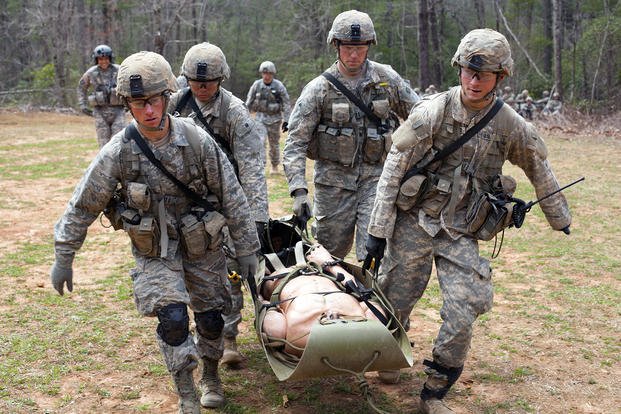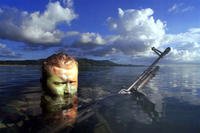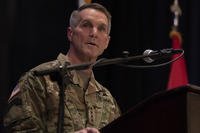FORT BENNING, Ga. -- Rangers from B Company, 3rd Battalion, 75th Ranger Regiment, were a month into their 18th battalion deployment, since 2001, to Afghanistan.
Their mission was to conduct a helicopter infiltration to capture or kill a known Taliban high-profile attack coordinator.
Serving as the platoon medic for more than two years, Cpl. Bryan Anderson had conducted numerous operations with the men he called his brothers.
Upon reaching the location of the enemy compound, a suicide vest was initiated. Anderson, around 300 meters away from the objective due to the enemy retreating, heard an explosion and the call on the radio.
"Hey! We need doc!"
Anderson joined the Army in 2010 on a Ranger contract to serve as a medic. After going to college in Arizona to study emergency response operations, he felt it was the path for which he was chosen.
Always wanting to be a firefighter, Anderson said of being a platoon medic, "I know I will never have a better job than the one I have right now, being a platoon medic with the other Rangers I serve with."
After joining the 1st Platoon, he deployed to Afghanistan for the first time in 2012. Having a few eventful missions with his platoon, Anderson knew what was expected of him.
"The whole time I've been in [the Ranger] regiment, I've taken my job very seriously," he said. "Sometimes you are the only medical provider on the ground, and when something bad does happen, all of a sudden, you become the leader, and everybody looks to you for what to do next. I wanted to be that calm voice in the middle of all the chaos on what the next step needed to be."
During his second deployment, not more than a month on ground, Anderson had to be that "calm voice" when the mission turned chaotic.
Anderson arrived at the first casualty and began his assessment by checking the treatments that already had been applied through the first responder care. The casualty had an effective tourniquet in place, his airway was intact and he reported no difficulty breathing. He moved to the chest, finding a penetrating chest wound to the casualty's left side. Applying an occlusive dressing, Anderson checked for effectiveness and continued his assessment.
No more than a few minutes into his assessment, a pressure-plate improvised explosive device, known as an IED, detonated a few meters from Anderson's position, which created another casualty. Upon completion of the first casualty's assessment, Anderson grabbed a fellow Ranger to stay with him and moved through an active IED field to treat the second casualty.
As he approached the second casualty, he noticed the multiple blast injuries on the entire left side of the body. He assessed a left leg amputation, left arm amputation at the elbow, abdominal evisceration and various other injuries. After treating the wounds, Anderson instructed another Ranger to assist in the treatment.
Though the casualty was unresponsive, Anderson made every attempt to help.
His last measure was to make a vertical incision in the throat and insert a definitive airway. It was then that the casualty took his last two breaths before showing no signs of life.
Just then, a third IED detonated 10 meters from Anderson's location, resulting in a third casualty. He moved to the location and immediately noticed bilateral leg amputations. Having run out of tourniquets, Anderson applied manual pressure to the femoral arteries.
Then, an Air Force pararescue jumper arrived to assist with the application of the tourniquets. Shortly thereafter, the patient lost consciousness and went into respiratory distress. The pararescue jumper began the vertical incision, and Anderson assisted by preparing his equipment for the cricothyroidotomy. Then another IED was detonated five meters from their location, throwing Anderson and the pararescue jumper from the casualty. After regaining consciousness, Anderson consulted with the pararescue jumper to ensure he could finish the procedure and moved to the fourth casualty.
Anderson arrived at the fourth casualty, who also had sustained bilateral leg amputations. Again, he applied manual pressure to the femoral arteries with both knees while waiting for additional tourniquets. He reached for one off the casualty's equipment and yelled to a fellow Ranger for another. After the tourniquets were applied, Anderson assessed the remaining injuries to the casualty and began prepping him for evacuation. An aid and litter team arrived, and with his instruction, he loaded the casualty onto the litter. Anderson then accounted for the two urgent casualties, relocated the pararescue jumper to the first casualty and moved his element to the landing zone.
When the aircraft had loaded the casualties, Anderson conducted a casualty handover with the flight surgeon onboard. He continued treating en route to the combat support hospital on the fourth casualty.
Anderson praised the other Rangers and others on ground for their quick responses to help treat others.
"We couldn't have done any of this without the platoon being so good at RFR [Ranger First Responder]," he said. "They were all doing an amazing job at treating what they knew how to treat, before a medic made it over there."
In summary, Anderson ran throughout the objective area to four different patients without the area being cleared by explosive ordnance disposal technicians to treat his fellow Rangers.
"To be honest, not once until I was moving to Josh [Hargis] was I was thinking I should be careful moving around here," he said. "They do a fantastic job training us, but they never train us to hold back. So when you see your buddy hurt and there is no enemy to fight, your immediate reaction is to run to your buddy."
According to his nomination for the U.S. Army Special Operations Command Medic of the Year, "His utter disregard for his own safety in order to treat patients was astounding, and his efforts to deftly perform intricate and complicated medical procedures with minimal equipment was incredible. Spc. Anderson directly contributed to saving two Rangers' lives, including that of a double amputee, whom Spc. Anderson kept alive for almost two hours until the casualty evacuation helicopter could land, refusing to leave a fallen comrade despite his own life being in extreme danger."
Want to Know More About the Military?
Be sure to get the latest news about the U.S. military, as well as critical info about how to join and all the benefits of service. Subscribe to Military.com and receive customized updates delivered straight to your inbox.











